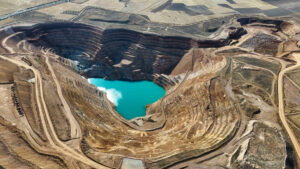Burns copper-gold system continues to expand with 244m hit for Lefroy

Pic: Bloomberg Creative / Bloomberg Creative Photos via Getty Images
What makes a porphyry copper-gold system really sing is its scale.
Lefroy Exploration (ASX:LEX) is demonstrating just that at its Burns discovery 50km from Kalgoorlie, where new exploration results continue to expand a find that has excited the market since an initial hit in February.
Lefroy shares were up almost 10% in early trade this morning after it struck more than 240m of continuous copper and gold mineralisation in drilling in the Western Basalt at the Burns copper-gold prospect.
In a region known for its quartz hosted gold veins and nickel sulphides, this drilling is adding weight to Lefroy’s concept that a large porphyry system under shallow cover will be outlined at Burns.
Significant new assay results from the first four of a nine-hole, 2328m RC program include:
- 244m at 0.14% Cu & 0.10g/t Au from 20m and 24m at 0.12% Cu & 0.46g/t Au from 306m to EOH (268m of total mineralisation).
- 68m at 0.15% Cu & 0.05g/t Au from 24m and 27m at 0.16% Cu & 0.18g/t Au from 110m (95m of total mineralisation).
Lefroy managing director Wade Johnson said the 244m hit in LEFR289 was “outstanding by any measure”.
“With oxide mineralisation commencing immediately beneath the shallow cover and over at least 250m of strike, this provides an easily accessible style of mineralisation for future development options,” he said.
“The new copper and gold mineralisation in the Western Basalt is wide open and when combined with the recent results from the Eastern Porphyry, demonstrates the emerging larger scale of this unique mineral system.
“LEX will commence follow-up RC drilling soon to further expand Burns and test the limits of this intrusion-related system both on land and out on Lake Randall.”
Reappraisals show western basalt stacks up
A number of previous holes dating as far back as March have also been reappraised, demonstrating similar copper-gold intercepts exist over a 250m strike length in the Western Basalt.
That included a strike of 282m @ 0.12% Cu & 0.43g/t Au from 24m, and a higher grade hit of 110m @ 0.53% Cu & 0.31g/t Au from 20m (a hole that initially returned 62m at 0.47g/t Au and 0.45% Cu from 68m.)
Assays for the final five holes from the recent drilling program are due by the end of the month.
A hole was also drilled at Smithers, 250m to the north, also intersected diorite porphyry, similar to that at Burns, containing two narrow (3-5m) intervals of pyritic magnetite veining.
This demonstrates the system at Burns continues up to Smithers, a strike length of at least 500m.
Burns is emerging as a multi-stage prospect hosting several different kinds of mineralisation, and more targets have been identified to the north as well as under Lake Randall in an aeromagnetic survey.
“Planning of the next phase of RC drilling to evaluate Burns, Smithers and north of Smithers is in progress,” Lefroy said.
“RC drilling is scheduled to commence in late September and planning for drilling of geophysical targets on Lake Randall in CY2021 has commenced.
“These programs aim to build scale to the system and demonstrate the Burns prospect is part of a much larger mineralised intrusive system.”
This article was developed in collaboration with Lefroy Exploration, a Stockhead advertiser at the time of publishing.
This article does not constitute financial product advice. You should consider obtaining independent advice before making any financial decisions.
Related Topics

UNLOCK INSIGHTS
Discover the untold stories of emerging ASX stocks.
Daily news and expert analysis, it's free to subscribe.
By proceeding, you confirm you understand that we handle personal information in accordance with our Privacy Policy.








